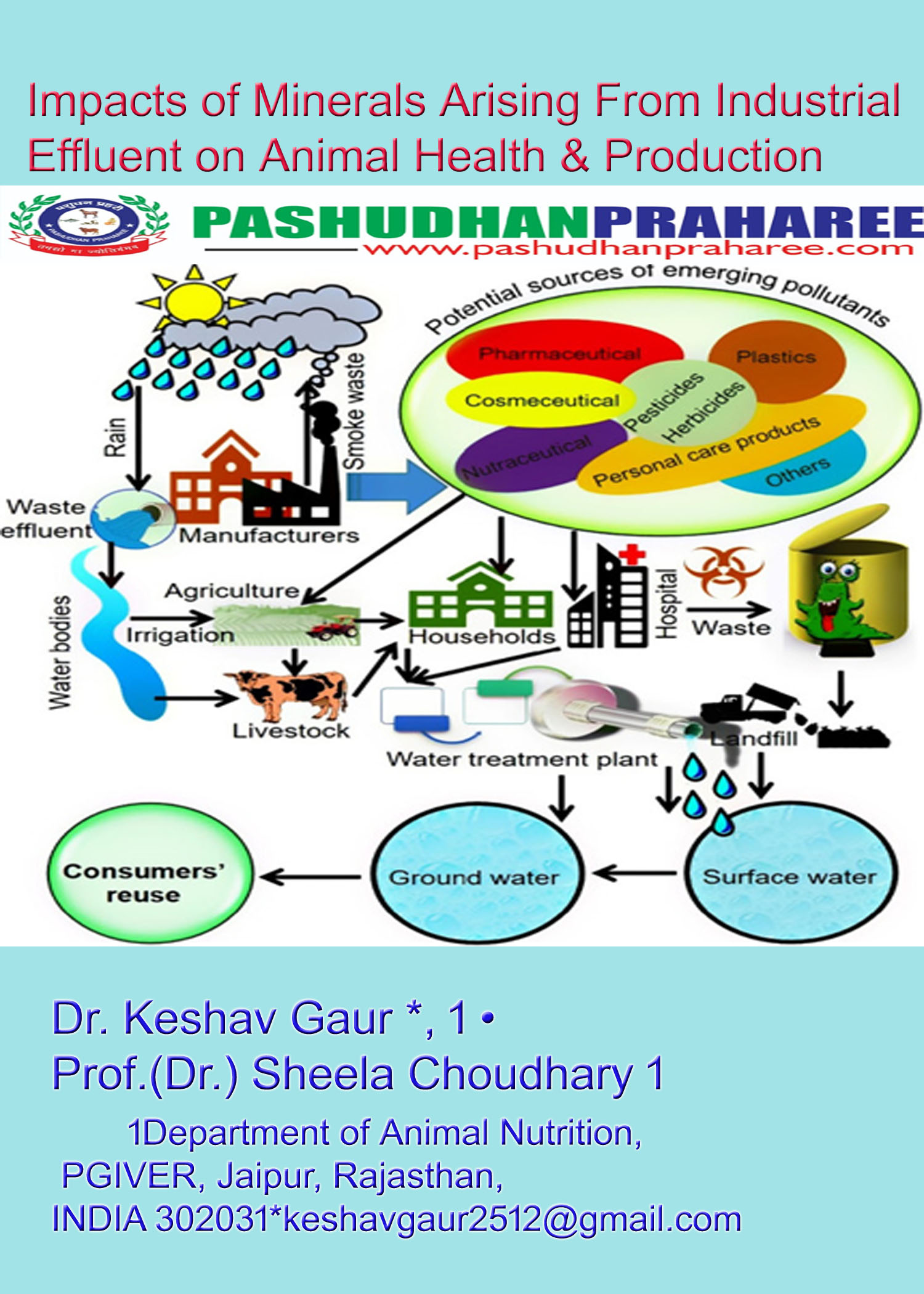Impacts of Minerals Arising From Industrial Effluent on Animal Health & Production
- Dr. Keshav Gaur *, 1 • Prof.(Dr.) Sheela Choudhary 1
1Department of Animal Nutrition, PGIVER, Jaipur, Rajasthan, INDIA 302031
*keshavgaur2512@gmail.com
Introduction:
Industrial effluents are the discharges from various industries which have have been found in different water resources. Industrial effluents are now-a-days very often polluted by high levels of toxic metal ions due to increasing use of metals in different fields like mining & smelting of metalliferous ores, surface finishing industry & application of fertilizers & pesticides , iron & steel metallurgy , electroplating , electrolysis, electro-osmosis, leatherworking(tannery) , photography , metal surface treating, aerospace & atomic energy plants. Consumption of such contaminated water influences animal health & production.
Effect of different minerals present in industrial effluents:
Heavy metals are those having density >5g/cm3 & are toxic even at ppb level. Examples include Pb, As, Hg, Cd, Zn, Ag, Cu, Fe, Cr, Ni, Pd, Pt. These are non-biodegradable & therefore tend to bioaccumulate & most of them are known to be carcinogens & create adverse ill effect on health & production of animals.
Heavy metals induces detrimental effects, including developmental toxicity, cell death, neuro-toxicity, oxidative stress & immunotoxicity, impaired cardiovascular effects, changes in animal behaviour, irregularity in estrus cycle, infertility, production of poor quality seman & impairement of locomotor activity and so on. Heavy metal poisoning can be caused by industrial exposure, contaminated air, water, food cycle, medicines etc.
Generally; following minerals arising from industrial affluent are known to affect animal health & production are- Pb, As, Hg, Cd, Zn, Ag, Cu, Fe, Cr, Ni, Pd, Pt, Al, V, F, Li, B.
- Arsenic (As)- Produce Gastro-enterirtis (Rice-watery diarrohea) & some nervous signs like depression, incoordinated gait, convulsions etc. , brick red mucus membrane. In pigs chronic Arsenic poisoning leads to demyelination of nerve fibre so produce sitting dog posture & tying up condition in horses.
- Mercury (Hg) – Characterized by inflammation of alimentary mucosa & damage to kidney & clinically manifested by gastroenteritis with haematemesis (by inorganic mercury form), Neurological signs like ataxia, incoordination, convulsion, abnormal behaviour etc. (by organic mercury form) , Pulmonary symptoms like dyspnoea (by elemental form) & terminally mercury poisoning signs is manifested by uraemia.
- Lead poisoning (Pb) (Plumbism) – Involvement of GIT & nervous system. These include ataxia, blindness, salivation, spastic twitching of eyelids, muscle tremors , jaw champing & convulsions. In chronic cases, progressive wasting of animal, anaemia. In dogs & horses; slate-coloured lead line of PbS on the gum margins.
- Cadmium (Cd) – Cadmium has higher affinity for proteins & damages mucous membrane of GIT & Respiratory tracts. Cd also damages hepatic & renal tissues. Cadmium toxicity is clinically manifested by vomition, abdominal pain, diarrohea, loss of appetite, dysponea, coughing, pulmonary oedema. Chronic poisoning will results in severe anaemia, proteinuria, retarded growth & osteoporosis.
- Copper (Cu)– Produces molybdenum deficiency in sheep, progressive hepatic damages, renal failure due to clogging of renal tubule with haemoglobin and necrosis of renal tubules & glomerulus. Affected animal faeces contain mucus & are of deep green colour, port-wine colour urine, severe anemia due to haemolytic crisis.
- Flouride (F) – MPL is 40-50ppm for cattle & 200 ppm for chickens. Flourine interfere with absorptions of cations like Calcium, magnesium, manganese; therefore produce symptoms associated with deficiency of these elements. Excessive intake of fluoride results into Dental & skeletal fluorosis along with periodic & intermittent moving type lameness Clinically manifested as diagonal walking, reduced appetite, difficulty in mastication , mottling of teeth, brown staining of teeth, hypoplasia of enaemal & dentine.
- Zinc (Zn) – Excess zinc intake will results in irregular estrus cycle & Infertility in females animals. Zinc toxicity is also known to cause Dag effect in the spermatozoa therefore increase the chances of repeat breeding in animals. Signs progress from anorexia, vomiting, diarrohea,lethargy to more advanced signs such as intravascular haemolysis, icterus, cardiac arrhythmias & seizures. Large animal often shows decrease in weight gain & milk production & lameness has been reported in foals secondary to epiphyseal swelling.
- Aluminium (Al) – Clinical signs include retarded growth, seizures, convulsion & muscle twitching, which resolved gradually after removing the cause
- Chromium (Cr) – chronic chromium toxicosis would result in skin-contact dermatitis, irritation of respiratory passage, ulceration & perforation of the nasal septum & lung cancer.
- Boron (B) – High boron intake has been shown to be detrimental to riboflavin inducing riboflavinuria. Therefore produces symptoms associated with riboflavin deficiency like curled toe paralysis in chickens.
- Iron (Fe) – Excesive intake of iron will result into deposition of storage form of iron in liver, spleen & kidney known as “siderosis”. High iron take also inhibit copper & phosphorous absorption therefore produces symptoms associated with deficiency of such elements. It also damages intestinal mucosal cells.
- Phosphorous (P) – effluents coming from fertilizer industry contain phosphorous , which can produce symptoms like abdominal pain, colic, profuse luminous vomitus, severe diarrhoea(often haemorrhagic) & garlic-like odour breath. In chronic cases it creates a condition known as phossy jaw.
- Lithium (Li) – In cattle signs of intoxication are salivation, depression, anorexia, hypodipsia, anuria, diarrhoea, ataxia, drowsiness, loss of body mass, seizures & dullness etc.
Conclusion:
As industrial effluent contains so many toxic elements. In order to avoid any impact on animal health & production; industrial effluent must be treated well before their release into water bodies, to nullify the effect of undesirable by products.


